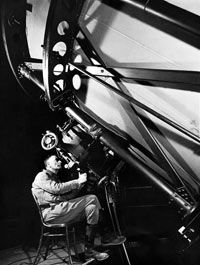Scientific Method Parts, Continued
Part 5
Science is an intellectual pursuit. Making observations and collecting data are not the ultimate goals. Data must be analyzed and used to understand the world around us. This requires inductive reasoning, or the ability to derive generalizations based on specific observations. There are many classic examples of inductive reasoning throughout the history of science, but let's look at one to understand how this intellectual exercise works.
In 1919, when Edwin Hubble (of Hubble Space Telescope fame) arrived on California's Mount Wilson to use the 100-inch (254-centimeter) Hooker Telescope, then the world's largest, astronomers generally believed that the entire universe consisted of a single galaxy — the Milky Way.
Advertisement
But as Hubble began making observations with the Hooker Telescope, he noticed that objects known as "nebulae," thought to be components of the Milky Way, were located far beyond its boundaries. At the same time, he observed that these "nebulae" were moving rapidly away from the Milky Way. Hubble used these observations to make a groundbreaking generalization in 1925: The universe wasn't made up of one galaxy, but millions of them. Not only that, Hubble argued, but all galaxies were moving away from each other due to a uniform expansion of the universe.
Part 6
Science makes predictions and tests those predictions using experiments. Generalizations are powerful tools because they enable scientists to make predictions. For example, once Hubble asserted that the universe extended far beyond the Milky Way, it followed that astronomers should be able to observe other galaxies. And as telescopes improved, they did discover galaxies — thousands and thousands of them, in all different shapes and sizes. Today, astronomers believe that there are about 125 billion galaxies in the universe. They've also been able to conduct numerous experiments over the years to support Hubble's notion that the universe is expanding.
One classic experiment is based on the Doppler effect. Most people know the Doppler effect as a phenomenon that occurs with sound. For example, as an ambulance passes us on the street, the sound of its siren seems to change pitch. As the ambulance approaches, the pitch increases; as it passes, the pitch decreases. This happens because the ambulance is either moving closer to the sound waves it is creating (which decreases the distance between wave crests and increases pitch) or moving away from them (which increases the distance between wave crests and decreases pitch).
Astronomers hypothesized that light waves created by celestial objects would behave the same way. They made the following educated guesses: If a distant galaxy is rushing toward our galaxy, it will move closer to the light waves it is producing (which decreases the distance between wave crests and shifts its color to the blue end of the spectrum). If a distant galaxy is rushing away from our galaxy, it will move away from the light waves it is creating (which increases the distance between wave crests and shifts its color to the red end of the spectrum).
To test the hypothesis, astronomers used an instrument known as a spectrograph to view the spectra, or bands of colored light, produced by various celestial objects. They recorded the wavelengths of the spectral lines, and their intensities, collecting data that eventually proved the hypothesis to be correct.
Part 7
Science is systematic. It is rigorous and methodical, requiring that tests be repeated so results can be verified. The hypothetical redshift described above has been proven in repeated experiments. In fact, it's so well documented that it has become an integral part of the Big Bang, a theory that describes how the universe expanded from an extremely dense and hot state.
So, science can be thought of as a way of thinking, but also as a way of working — a process requiring scientists to ask questions, make hypotheses and test their hypotheses through experimentation. This process is known today as the scientific method, and its basic principles are used by researchers in every discipline, in every part of the world.
And yet it was not always so — the move to scientific inquiry evolved slowly over time. In the next section, we'll look more closely at the history of the scientific method to better understand how it developed.
